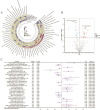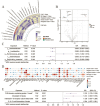The causal relationship between circulating inflammatory proteins, gut microbiotas, immune cells and leukemia: a bidirectional Mendelian randomization study
- PMID: 40537729
- PMCID: PMC12179026
- DOI: 10.1007/s12672-025-02863-y
The causal relationship between circulating inflammatory proteins, gut microbiotas, immune cells and leukemia: a bidirectional Mendelian randomization study
Abstract
Introduction: Numerous evidence have highlighted a robust association between inflammatory proteins, gut microbiotas, and immune cells and leukemia. However, the causal relationship remains poorly defined. To delve into this connection, we implemented a bidirectional Mendelian randomization (MR) study.
Materials and methods: This study utilized genetic variation data from publicly accessible genome-wide association study (GWAS) datasets. We used methods such as inverse variance weighting (IVW) to assess the causal relationship between exposure and the outcome of leukemia. Mediation analyses were applied to investigate the associations between immunophenotypes, gut microbiotas and inflammatory proteins and leukemia. Instrumental variables (IVs) mapping genes were identified, and functional analyses of the related genes were subsequently carried out. Sensitivity analyses was implemented to fortify the robustness of methods and results.
Results: This study uncovered four inflammatory proteins exhibiting significant associations with elevated leukemia risk, while leukemia exerted discernible effects on six inflammatory cytokines. IVW analysis revealed two immune cell subtypes with opposing roles on leukemia risk. One gut microbiota subtypes exhibited a pro-leukemogenic association, contrasted by four subtypes displaying protective influences. Enrichment analysis further identified three differentially expressed genes between malignant and adjacent normal tissues, with related genes demonstrated pronounced pathway enrichment in the mitogen-activated protein kinase (MAPK) signaling pathway.
Conclusion: These findings shed new light on the genetic associations between circulating inflammatory proteins, gut microbiotas, and immune cells and leukemia. It may not only enrich the understanding but also guide deeper clinical and basic research in this domain.
Keywords: Causal relationship; Circulating inflammatory proteins; Genome-wide association study; Leukemia; Mendelian randomization.
© 2025. The Author(s).
Conflict of interest statement
Declarations. Ethics approval and consent to participate: The sample for the study included human individuals and involved secondary analysis of previously published data, thus ethical approval was not necessary. Competing interests: The authors declare no competing interests.
Figures





Similar articles
-
Inflammatory cytokines mediate the gut microbiota-EGPA subtype link: a Mendelian randomization study.Clin Rheumatol. 2025 Jul;44(7):3061-3071. doi: 10.1007/s10067-025-07526-5. Epub 2025 Jun 12. Clin Rheumatol. 2025. PMID: 40500572
-
Genetic prediction of immune cells, inflammatory proteins, and metabolite-mediated association between gut microbiota and COPD: a Mendelian randomization study.Sci Rep. 2025 Jul 1;15(1):21633. doi: 10.1038/s41598-025-05290-9. Sci Rep. 2025. PMID: 40594427 Free PMC article.
-
Genetically predicted the causal association between serum mineral elements with immune thrombocytopenia and Henoch-Schonlein purpura: a bidirectional two-sample Mendelian randomization analysis.Thromb J. 2025 Jun 16;23(1):65. doi: 10.1186/s12959-025-00756-2. Thromb J. 2025. PMID: 40524203 Free PMC article.
-
Systemic pharmacological treatments for chronic plaque psoriasis: a network meta-analysis.Cochrane Database Syst Rev. 2021 Apr 19;4(4):CD011535. doi: 10.1002/14651858.CD011535.pub4. Cochrane Database Syst Rev. 2021. Update in: Cochrane Database Syst Rev. 2022 May 23;5:CD011535. doi: 10.1002/14651858.CD011535.pub5. PMID: 33871055 Free PMC article. Updated.
-
Intravenous magnesium sulphate and sotalol for prevention of atrial fibrillation after coronary artery bypass surgery: a systematic review and economic evaluation.Health Technol Assess. 2008 Jun;12(28):iii-iv, ix-95. doi: 10.3310/hta12280. Health Technol Assess. 2008. PMID: 18547499
References
Grants and funding
LinkOut - more resources
Full Text Sources
